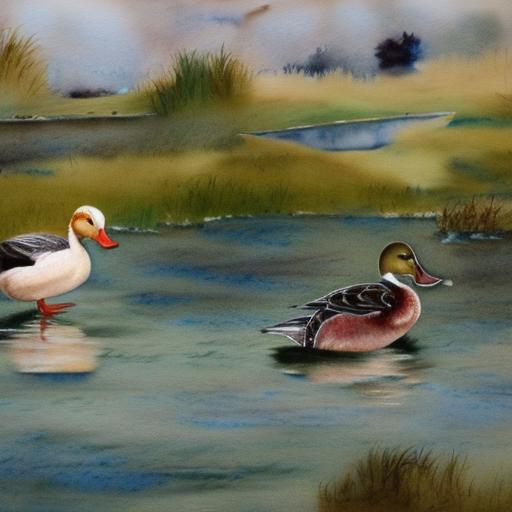Ducks come in a wide variety of breeds, each with its own unique characteristics and traits. Some popular duck breeds include the Pekin, Mallard, Rouen, Khaki Campbell, and Muscovy. Each breed has its own distinct size, coloration, egg-laying capabilities, and temperament. For example, Pekin ducks are known for their large size and white feathers, while Khaki Campbells are prized for their prolific egg-laying abilities. Understanding the differences between duck breeds is essential when considering mixing them in a flock. It’s important to research each breed thoroughly to ensure that they will be compatible with one another and meet your specific needs and preferences.
Duck breeds also vary in terms of their foraging abilities, adaptability to different climates, and overall hardiness. Some breeds may be better suited for free-ranging on a farm, while others may thrive in a more confined space. Additionally, certain breeds may be more resistant to common duck diseases and parasites. By understanding the unique characteristics of different duck breeds, you can make informed decisions about which breeds to mix in your flock and create a harmonious and productive environment for your ducks.
Key Takeaways
- Understanding Different Duck Breeds
- There are many different duck breeds, each with their own unique characteristics and traits.
- Factors such as size, temperament, and egg-laying abilities vary among different duck breeds.
- Factors to Consider When Mixing Duck Breeds
- Consider the compatibility of different duck breeds in terms of size, temperament, and foraging habits.
- Keep in mind the purpose of mixing duck breeds, whether it’s for egg production, meat, or simply for aesthetic variety.
- Tips for Successfully Mixing Duck Breeds
- Introduce new duck breeds gradually to allow for proper integration and minimize stress.
- Provide adequate space, food, and water to accommodate the needs of different duck breeds.
- Potential Challenges of Mixing Duck Breeds
- Aggression and territorial behavior may arise when mixing different duck breeds.
- Breeding and genetic considerations should be taken into account to avoid potential health issues.
- Benefits of Mixing Duck Breeds
- Mixing duck breeds can lead to increased genetic diversity and overall flock resilience.
- It can also result in a more visually appealing and interesting flock.
- Common Duck Breed Combinations
- Popular duck breed combinations include mixing Pekin and Khaki Campbell ducks, as well as incorporating Runner ducks for their foraging abilities.
- Conclusion: Finding the Right Mix for Your Flock
- When mixing duck breeds, it’s important to carefully consider the specific needs and characteristics of each breed to create a harmonious and successful flock.
Factors to Consider When Mixing Duck Breeds
When mixing duck breeds, there are several important factors to consider to ensure a successful and harmonious flock. One key consideration is the size and temperament of the different duck breeds. Some breeds, such as the Pekin, are larger and more dominant, while others, like the Khaki Campbell, are smaller and more docile. It’s important to consider how these differences in size and temperament may impact the dynamics within the flock. Mixing breeds with similar temperaments and sizes can help minimize potential conflicts and ensure that all ducks have equal access to food, water, and shelter.
Another important factor to consider when mixing duck breeds is their egg-laying capabilities. If you are raising ducks for their eggs, you may want to mix breeds that are known for their high egg production. For example, Khaki Campbell ducks are prolific layers, while Muscovy ducks are known for their rich and flavorful eggs. By mixing breeds with complementary egg-laying abilities, you can maximize your flock’s overall egg production and diversity. Additionally, it’s important to consider the climate and environment in which your ducks will be living. Some breeds may be better suited for cold or hot climates, so it’s important to choose breeds that can thrive in your specific location.
Tips for Successfully Mixing Duck Breeds
Successfully mixing duck breeds requires careful planning and consideration of various factors. One important tip is to introduce new ducks to the flock gradually. This can help minimize stress and potential conflicts among the ducks. When introducing new ducks, it’s best to do so in a neutral territory where all ducks have equal access to food, water, and shelter. This can help prevent territorial disputes and allow the ducks to establish a new pecking order without too much disruption.
Another tip for successfully mixing duck breeds is to provide ample space for the ducks to roam and forage. Ducks are naturally social animals, but they also need space to establish their own territories and avoid overcrowding. Providing plenty of space can help reduce aggression and competition among the ducks. Additionally, it’s important to provide multiple feeding and watering stations to ensure that all ducks have equal access to essential resources. This can help prevent bullying and ensure that all ducks receive adequate nutrition and hydration.
Potential Challenges of Mixing Duck Breeds
While mixing duck breeds can have many benefits, there are also potential challenges to consider. One common challenge is the potential for aggression and bullying among different breeds. Ducks have their own social hierarchies, and introducing new breeds can disrupt the established pecking order. This can lead to aggression, bullying, and even injury among the ducks. It’s important to monitor the flock closely when introducing new breeds and be prepared to separate any ducks that are being overly aggressive or causing harm to others.
Another potential challenge of mixing duck breeds is the risk of disease transmission. Different duck breeds may have varying levels of resistance to common duck diseases and parasites. Introducing new breeds without proper quarantine and health checks can increase the risk of disease transmission within the flock. It’s important to work with a veterinarian or experienced poultry professional to ensure that all ducks are healthy and free from any potential illnesses before introducing them to the flock.
Benefits of Mixing Duck Breeds
Despite the potential challenges, there are many benefits to mixing duck breeds in a flock. One key benefit is genetic diversity, which can help improve overall flock health and resilience. By mixing different breeds, you can introduce a wider range of genetic traits and characteristics into the flock, which can help reduce the risk of inbreeding and genetic disorders. This can lead to healthier, more robust ducks that are better able to adapt to changing environmental conditions.
Another benefit of mixing duck breeds is increased productivity. By selecting breeds with complementary traits, such as high egg production or superior foraging abilities, you can create a more productive and efficient flock. For example, mixing a breed known for its excellent egg-laying capabilities with a breed known for its superior foraging skills can result in a flock that produces both abundant eggs and thrives on natural forage. This can lead to higher overall yields and reduced reliance on commercial feed.
Common Duck Breed Combinations

There are many different combinations of duck breeds that can be successfully mixed in a flock. One common combination is mixing Pekin ducks with Khaki Campbells. Pekin ducks are prized for their large size and meat production, while Khaki Campbells are known for their prolific egg-laying abilities. By mixing these two breeds, you can create a versatile flock that produces both meat and eggs. Another popular combination is mixing Rouen ducks with Muscovy ducks. Rouen ducks are known for their beautiful plumage and calm temperament, while Muscovy ducks are prized for their rich and flavorful eggs. By mixing these two breeds, you can create a visually stunning flock that produces delicious eggs.
Another common combination is mixing Mallard ducks with Indian Runner ducks. Mallard ducks are known for their wild and independent nature, while Indian Runner ducks are prized for their upright posture and excellent foraging abilities. By mixing these two breeds, you can create a diverse flock that thrives in both free-range and confined environments.
Finding the Right Mix for Your Flock
In conclusion, mixing duck breeds can be a rewarding endeavor that offers many benefits, including genetic diversity, increased productivity, and a visually stunning flock. However, it’s important to carefully consider the unique characteristics of each breed and take steps to minimize potential challenges such as aggression and disease transmission. By following the tips outlined in this article and carefully selecting compatible breeds, you can create a harmonious and productive flock that meets your specific needs and preferences. Whether you’re raising ducks for meat, eggs, or simply as pets, finding the right mix of duck breeds can lead to a successful and fulfilling experience as a duck owner.
If you’re interested in mixing different duck breeds, you may also want to consider the best diet for your ducks. Poultry Wizard offers a helpful article on “What Should You Feed Ducks” that provides valuable insights into the nutritional needs of ducks and the ideal diet to keep them healthy and thriving. Understanding the dietary requirements of your ducks is essential when considering mixing different breeds, as it can impact their overall well-being and productivity. Check out the article here for expert advice on feeding your ducks.
FAQs
What are the benefits of mixing duck breeds?
Mixing duck breeds can result in a more diverse gene pool, which can lead to healthier and more resilient ducks. It can also create unique and interesting color patterns and feather variations.
What should be considered when mixing duck breeds?
When mixing duck breeds, it’s important to consider the compatibility of the breeds in terms of size, temperament, and environmental adaptability. It’s also important to consider the potential for hybrid vigor and any potential genetic issues that may arise.
Can mixed duck breeds still be used for egg production?
Yes, mixed duck breeds can still be used for egg production. However, it’s important to note that the egg production may vary depending on the specific breeds that are mixed.
Are there any potential drawbacks to mixing duck breeds?
One potential drawback of mixing duck breeds is that it can result in unpredictable offspring in terms of size, color, and temperament. Additionally, there may be challenges in finding suitable mates for the mixed breed ducks if breeding is desired.
What are some popular duck breeds that are commonly mixed?
Some popular duck breeds that are commonly mixed include the Pekin, Mallard, Rouen, Khaki Campbell, and Indian Runner. These breeds are often mixed to create unique and visually appealing ducks.
Meet Walter, the feathered-friend fanatic of Florida! Nestled in the sunshine state, Walter struts through life with his feathered companions, clucking his way to happiness. With a coop that’s fancier than a five-star hotel, he’s the Don Juan of the chicken world. When he’s not teaching his hens to do the cha-cha, you’ll find him in a heated debate with his prized rooster, Sir Clucks-a-Lot. Walter’s poultry passion is no yolk; he’s the sunny-side-up guy you never knew you needed in your flock of friends!







